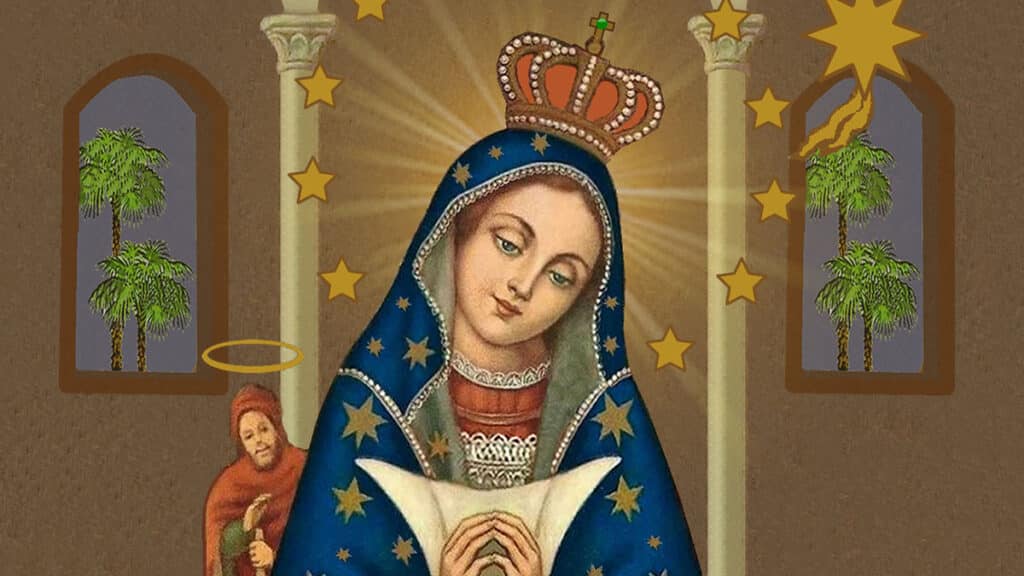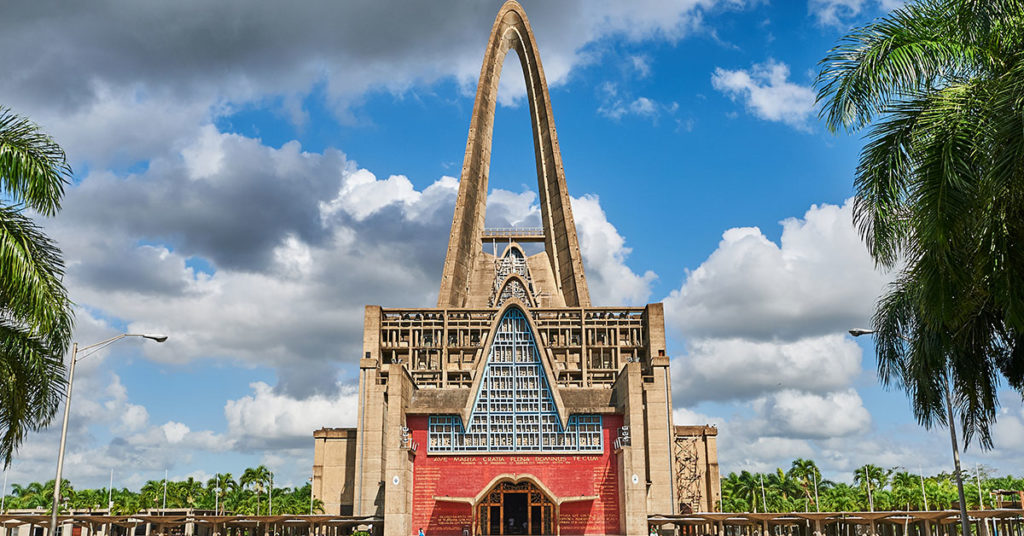
La Virgen de la Altagracia (Our Lady of Highest Grace) is the patron saint of the Dominican Republic, and icon of the Dominican people.
Her feast is celebrated on January 21 with a pilgrimage to the Basílica Catedral Nuestra Señora de la Altagracia where her sacred image is kept in Salvaleón, Higüey, Dominican Republic.
Nuestra Señora de la Altagracia
The spiritual mother of Dominican Catholics is a small painting of the Virgin mother and child in a nativity scene. You can recognize her by the white scapular (devotional cloak) covering her chest. The eight-pointed star represents the Star of Bethlehem. The twelve stars around the Virgin’s head represent the twelve apostles.
The Story of Our Lady of Highest Grace
Her story is often richly embellished, but basically a Dominican child asked her merchant father for an image she dreamed of. He couldn’t find the image and while complaining about it, an old wanderer pulled an image from a bag, gave it to him and disappeared.
The merchant’s daughter claimed that it was the exact image of her dream. But the image kept disappearing from the girl’s room and was found each time under an orange tree. A cathedral was built on the spot. Oranges originate in Asia, but came to the Americas from Spain. Spaniards planted them so their sailors could avoid scurvy by eating the fruit. Anyway, that is why people offer the image oranges.
The Feast and Pilgrimage

Her feast was originally in August, but was moved to January 21 to commemorate a victory over French forces in the Battle of Sabana Real in 1691. The Dominican Republic shares the island of Hispaniola with Haiti which was founded from the horrific French sugar colony Saint Domingue (1659-1804). There is still tension between Dominicans and Haitians, although we think it’s better pointed at the French, Spanish and British colonizers who divided the island and the people on it. It’s not the people’s fault.
Today there is a pilgrimage of almost a million people to the cathedral every year starting on the eve of January 21st.
Dominicans in New York City are in diaspora. That makes devotion to the old country and traditions even more intense. This feast marks the start of Dominican Heritage Month in New York City (January 21 – February 27).
La Virgen de la Altagracia represents the spirit of the Dominican Republic.
Kíko’s Altagracia Story
I arrived in the Dominican Republic in the beginning of February, shortly after La Altagracia’s feast day, and took a room on the corner of Parque Colón in Santo Domingo’s Colonial Zone, near one of the 500-year old sacred trees on the plaza. Knowing that La Altagracia is the patroness of the Dominican Republic, I lit a candle and prayed to her.
In the Caribbean, most Catholic saints have a syncretized African pair, so I started searching for La Altagracia’s pair. I couldn’t find one, but the search led me to the Yowa or Dikenga Cross, the Kongo cosmological diagram. It’s a cross with a counterclockwise circle called the mbûngi. The diagram represents the sun’s daily journey across the sky, the physical and spiritual worlds, and the journey of life through the stages of conception, birth, maturity, and death.
The horizon line is the Kalûnga. It separates the physical and spiritual worlds. In the Central African Kongo context, the Kalûnga also represents the Atlantic Ocean. Kongo peoples knew that those who were kidnapped and taken across the water towards the setting sun, never returned.
Though comfortable with African Diaspora religions, I never heard of the Kalûnga before. That week I got a job promoting the Dominican singer Xiomara Fortuna. She has been a champion of Afro-Dominican culture throughout her career, but after a 2021 heart attack decided that she had to say whatever she has to say, now while she still can. Her album “Etaquetúves” (It is what you see with a working-class Dominican accent) is a series of journeys. She sings about the Kalûnga, and her album art uses the image of a pipe rising out of the water. It’s the “tukula,” the vertical line in the Yowa that symbolizes maturity. I was surprised that something I never heard of before suddenly showed up in a prayer and in my work.
Joseph Campbell’s “Hero of a Thousand Faces” is a book I read in college, more than 40 years ago, that continues to be part of my work. Campbell was the master of world myth and folklore. His thesis is that people do similar things around the world and across time because we are all human. I’m reading the book again because it was my first deep introduction to world culture, and now I’m a culture writer. So I turn a page, and there is a horizon line with a counterclockwise circle. It was the Yowa again, now representing the psyche’s journey through life.
I’m one of the best Argentine tango dancers in the Caribbean. The tango line of dance is counterclockwise. That always seemed strange to me, but now I know why. Tango came to South America from Central Africa where Kongo culture originates. I was taught long ago that the dance and the dance circle are sacred. We dance the tango around the Yowa, the Kongo representation of life’s journey.
Maybe it’s just coincidence and the imaginings of a storyteller, but I thought it was pretty marvelous that La Virgen de la Altagracia, a Catholic saint who represents Spain, led me to Kongo religion, and her lesson suddenly showed up multiple times in my life.
Everything you do on a computer or on the internet is tracked, so I tried to retrace my steps from La Altagracia to Kalûnga. I couldn’t find any trail. It’s as if I followed an unseen hand. I’m not sure what to make of it, but whenever I pass a church dedicated to La Altagracia, I stop and thank her.
Last time I did, I stopped to take a picture of the church and heard my name, “Kíko,” “Kíko.” I thought, OMG, La Altagracia is calling me directly. Turns out it was a friend who stopped by church too because it’s La Altagracia’s month in the Dominican Republic. LOL. How wonderful is it for a stranger in a strange land to run into people he knows on the street? Señora, te quiero mucho y te agradezco lo que me diste.
Dios te bendiga. ¡Aché!
Editor “Kíko” Kí
